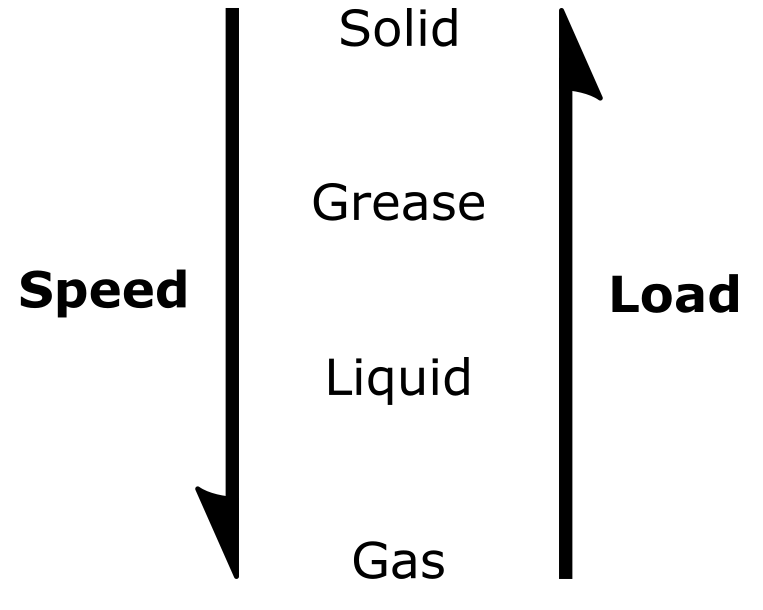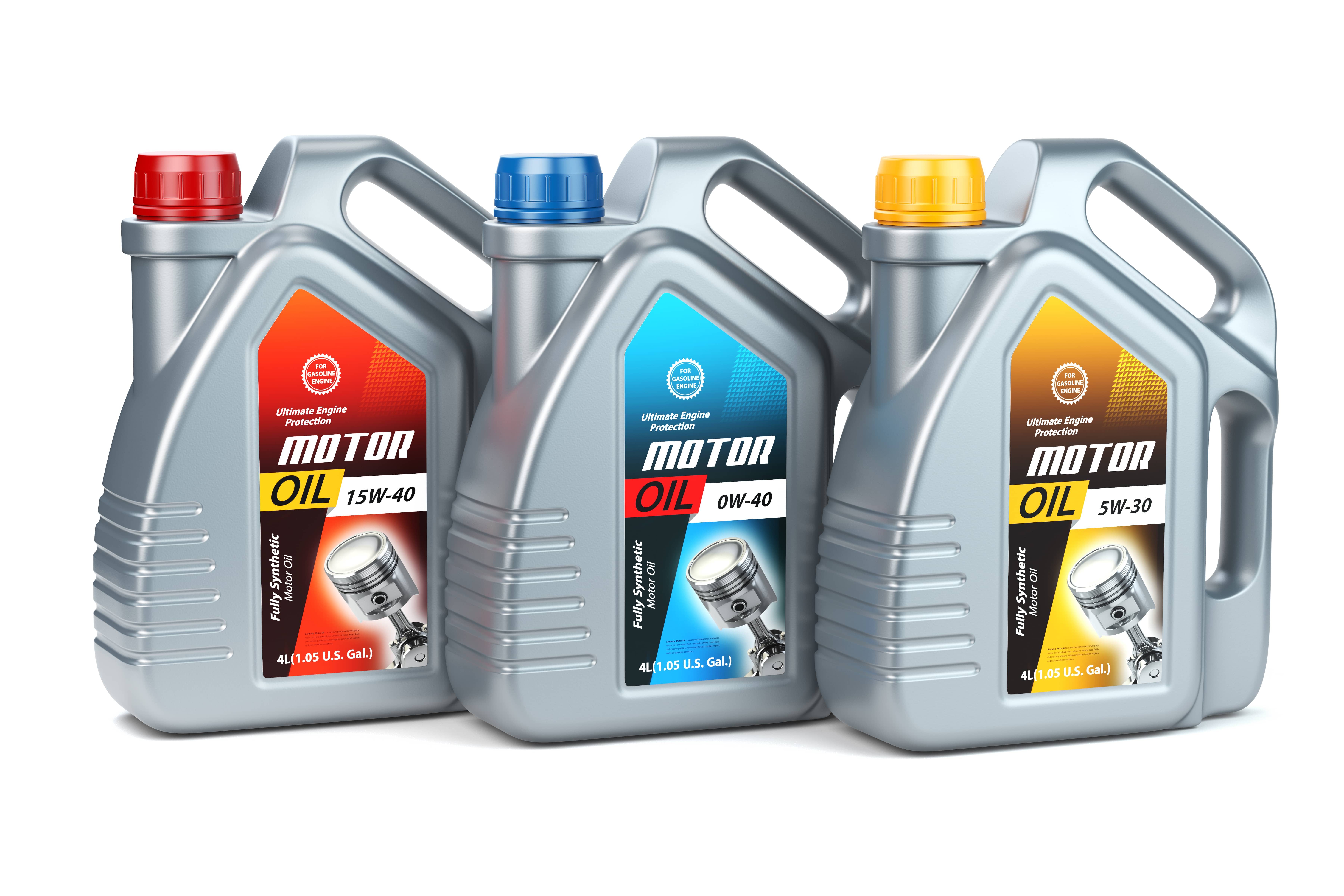Bearing Lubrication
All bearings have some form of lubricant. Lubricants provide a means of reducing friction, which in turn reduces heat and wear. Lubricants also protect the bearing surfaces from corrosion and foreign particle contamination.
Typical plain bearing lubricants may include compressed air, compressed nitrogen, molten metals, water, kerosene, liquid refrigerants, oils, or greases (to name a few). Typical anti-friction bearing lubricants may include mineral oil, grease, and vegetable-based oils (to name a few).
Before discussing the types of bearing lubricants available, an understanding of desired lubricant properties is needed. It is important to remember that incorrect lubrication (too much or too little) is a common reason for bearing failure.
Viscosity
Viscosity determines a lubricants resistance to flow; it is the most important characteristic of a lubricant. Sticky honey has a high viscosity whilst water has a low viscosity. Generally, higher viscosity lubricants are used for higher loads and lower speeds. Lower viscosity lubricants are used for lower loads and higher speeds.
Tip: If you can’t remember if thicker liquids are high or low viscosity, exchange the word ‘viscosity’ for ‘resistance to flow’ e.g. ‘honey has a high viscosity’ becomes ‘honey has a high resistance to flow’.

Lubricant Applications
Viscosity Index (VI)
The viscosity index (VI) describes the relationship of a lubricant’s viscosity at temperature.
- A high viscosity index indicates that the lubricant is not greatly affected by temperature changes.
- A low viscosity index indicates that the lubricant is greatly affected by temperature.
Flash Point, Fire Point and Pour Point
Other important factors for lubricants are the flash point, fire point and pour point.
- Flash point – the lowest temperature at which vapours created by a material will ignite.
- Fire point – the lowest temperature at which vapours created by a material will continue to burn even after the ignition source is removed.
- Pour point – the temperature at which a liquid ceases to flow (under gravity).
The flash point and fire point are particularly important when selecting lubricants for high temperature applications. An incorrect lubricant chosen for high temperature applications may lead to a fire hazard.
The pour point is particularly important when selecting lubricants for low temperature applications. An incorrect lubricant chosen for low temperature applications may lead to the lubricant freezing, which will stall pumps as well as damage any components that no longer receive lubrication.
Lubricants Types (animal, plant, oil and synthetic)
The traditional bearing lubricant was animal fat. Fat from domesticated animals such as cattle, pigs and goats, was used as lubricant for many applications, including greasing war chariot axles. Later lubricants were plant/vegetable based, such as palm, caster, sunflower, rapeseed and soya. Almost all modern lubricants are mineral oil based or synthetic.
There are many different lubricants available due to the numerous equipment items, in numerous different systems, that must be lubricated. Pressure, temperature, speed and load, are just some of the factors that affect lubricants. Speed may not be an obvious factor, but the centrifugal forces (centripetal in terms of true physics) a machine creates during operation may displace the lubricant, which leads to friction and wear.
Mineral oil-based lubricants are by far the most popular lubricant because they are cheap and versatile. Synthetic lubricants generally cost much more than mineral oil-based lubricants and are thus not as common. Animal fat-based lubricants are not viable for many applications due to their comparatively low availability (the modern world would need to slaughter many animals continuously to feed its current lubrication demands); an additional problem with animal fats is that some religions do not allow for the handling of certain animal fats e.g. swine/pig fat.
Vegetable oils have been experiencing a recent growth in use due to advances in technology. Vegetable oils can have many advantages over mineral oil-based lubricants, these include:
- A very high level of lubricity (i.e. its ‘slippy’).
- A high viscosity index.
- Higher flash points.
- Higher fire points.
Vegetable oil are also biodegradable, a factor that is becoming more relevant due to the expanding number of environmental pollution regulations. A common consumer of vegetable-based lubricants are industrial plants operating in the edible food industry; these plants are forced to use vegetable oil-based lubricants because of the risk associated with contaminating the product (people do not want to eat food that contains traces of mineral oil).
One of the largest disadvantages with vegetable oils is their rapid oxidation at high temperature compared to mineral oils. Oxidation of vegetable oil leads to a reduction in its lubricating properties.
Lubricant States (gas, liquid, semi-solid and solid)
Lubricants can be either gas, liquid, semi-solid or solid.
- Common gas lubricants include air, nitrogen and helium.
- Common liquid lubricants include mineral and vegetable oils.
- Common semi-solid lubricants include all types of greases (thickening agents can be soap or non-soap based).
- Common solid lubricants include graphite and certain polymersg. PTFE.
Gas Lubricants
Gas lubricants are used for very low load applications with very small separation/clearance between the contact surfaces. Gas lubricants lack the cooling and lubrication capabilities of other lubricants, but they can operate across a wide temperature range and do not vaporise, cavitate or decompose. Due to the very fine tolerances involved with this type of lubricant, specialist designers and manufacturers are required.
Liquid Lubricants
Liquid lubricants can carry high loads whilst also having desirable cooling and lubrication properties. Liquid lubricants can be fed to the point of use by gravity tanks, pumps, oil cups or by submerging the component within the liquid lubricant itself (vertical shaft thrust bearings often use this approach).

Lubrication Oil
Because heat can be removed from the lubricated area and cooled externally, liquid lubricants can be used for higher temperature applications than other lubricants. Generally, the viscosity of chosen liquid lubricants will decrease as the speed increases and increase as the load increases.
Semi-Solid
Semi-solid lubricants are liquid lubricants mixed with additives and thickening agents (often soap based e.g. sodium stearate, calcium stearate, or lithium stearate). Typical greases may consist of 75-95% oil, 0-5% additives and 5-20% soap. Greases have the advantage of remaining in-situ once applied, they do not need to be replenished often and they act as a barrier to seal out contaminants. The largest disadvantages with greases are their poor heat dissipation properties (poor ability to reject heat) and their inability to remove contaminants that may become entrained in the grease.
Solid Lubricants
Solid lubricants are more effective at higher loads and pressures than other types of lubricant, and they also offer good stability at elevated temperatures (material dependent). But compared to other lubricants, they have a higher coefficient of friction (generate more heat when in operation) with poor heat dissipating properties. Solid lubricants are rarely suitable for high speed applications.
Additional Resources
https://www.amroll.com/bearing-lubrication.html
https://koyo.jtekt.co.jp/en/support/bearing-knowledge/12-1000.html
